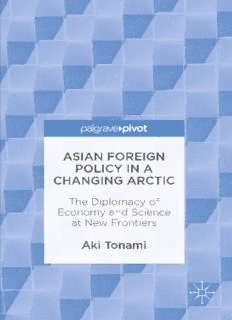
Asian Foreign Policy in a Changing Arctic: The Diplomacy of Economy and Science at New Frontiers PDF
Preview Asian Foreign Policy in a Changing Arctic: The Diplomacy of Economy and Science at New Frontiers
ASIAN FOREIGN POLICY IN A CHANGING ARCTIC The Diplomacy of Economy and Science at New Frontiers Aki Tonami Asian Foreign Policy in a Changing Arctic Aki Tonami Asian Foreign Policy in a Changing Arctic The Diplomacy of Economy and Science at New Frontiers Aki Tonami Nordic Institute of Asian Studies University of Copenhagen Copenhagen, Denmark ISBN 978-1-137-53745-4 ISBN 978-1-137-53746-1 (eBook) DOI 10.1057/978-1-137-53746-1 Library of Congress Control Number: 2016947421 © The Editor(s) (if applicable) and The Author(s) 2 016 The author(s) has/have asserted their right(s) to be identifi ed as the author(s) of this work in accordance with the Copyright, Designs and Patents Act 1988. This work is subject to copyright. All rights are solely and exclusively licensed by the Publisher, whether the whole or part of the material is concerned, specifi cally the rights of translation, reprinting, reuse of illustrations, recitation, broadcasting, reproduction on microfi lms or in any other physical way, and transmission or information storage and retrieval, electronic adaptation, computer software, or by similar or dissimilar methodology now known or hereafter developed. The use of general descriptive names, registered names, trademarks, service marks, etc. in this publication does not imply, even in the absence of a specifi c statement, that such names are exempt from the relevant protective laws and regulations and therefore free for general use. The publisher, the authors and the editors are safe to assume that the advice and information in this book are believed to be true and accurate at the date of publication. Neither the publisher nor the authors or the editors give a warranty, express or implied, with respect to the material contained herein or for any errors or omissions that may have been made. Cover illustration: Abstract Bricks and Shadows © Stephen Bonk/Fotolia.co.uk Printed on acid-free paper This Palgrave Macmillan imprint is published by Springer Nature The registered company is Macmillan Publishers Ltd. London To my family C ONTENTS 1 Introduction 1 2 China’s Arctic Policy 19 3 Japan’s Arctic Policy 47 4 Arctic Policy of South Korea (Republic of Korea) 73 5 Singapore’s Arctic Policy 93 6 India’s Arctic Policy 107 7 Conclusions 113 Index 127 vii P REFACE On 9 December 2013, after fl ying fi ve hours from Copenhagen, I set foot inside the Arctic Circle for the fi rst time in my life. I had arrived at Kangerlussuaq Airport, a former US Air Base and now a civilian airport in Greenland. As I came out from the plane, in the distance I saw enormous fl attop rocky mountains surrounding the airport. It was December— everything, virtually everything, was white. The scenery very much fi tted what I imagined as the Arctic. From there, we took another fl ight to the capital of Greenland, Nuuk, which lies outside of the Arctic Circle. Although still bitterly cold, it was a beautiful small town with colourful little houses. In Nuuk, I was given an opportunity to give a lecture on Japan’s Arctic policy and its relation to Greenland. The next morning, I stood in front of the audience that fi lled up a large hall at Ilisimatusarfi k, the University of Greenland. They were mostly ethnic Greenlanders interested in knowing more about Asia—university students, lecturers, business owners, government offi cials, and politicians alike. As I stood to begin my talk, I felt a strange sense of comfort as I looked around at their faces—they looked so much like me. This was very different from my usual experience of going abroad for work (or living in Denmark for that matter), where I am used to seeing different faces of dif- ferent colours. I knew the Inuits were what we know as Mongoloids, like me, a Japanese, but I could not quite process that, somehow, at a place so far away from Japan or East Asia, we were somehow connected. This happened at a time of much media debate around the idea that “China is coming to the Arctic.” Citizens (mostly non-Inuits) in the ix
Description: